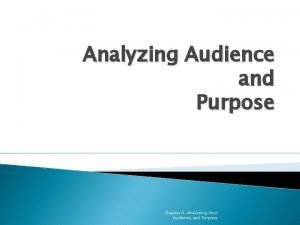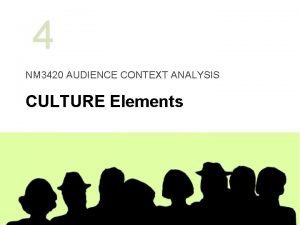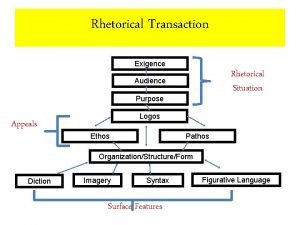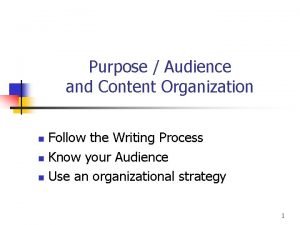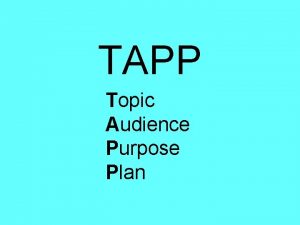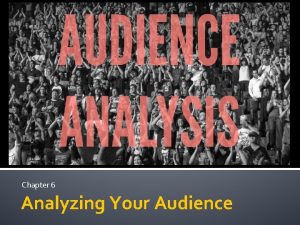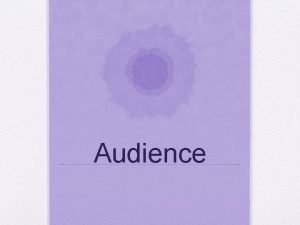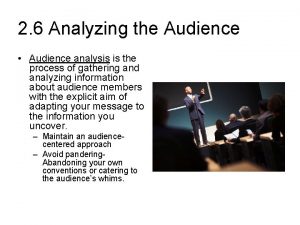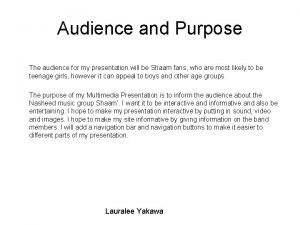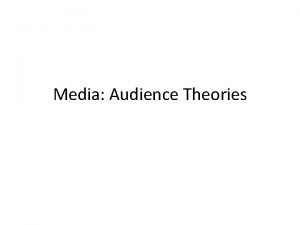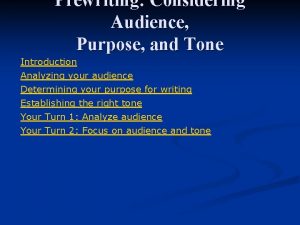Chapter 5 Analyzing Your Audience and Purpose Three


















- Slides: 18

Chapter 5 Analyzing Your Audience and Purpose

Three Steps in Analyzing an Audience n Three steps in analyzing an audience: 1. 2. 3. Identify primary and secondary audiences. Identify basic categories of readers. Identify individual characteristics of readers. Chapter 5. Analyzing Your Audience and Purpose 2

Start by classifying your readers into two categories: n Two categories of readers: 1. A primary audience of people who use your document in carrying out their jobs n n 2. Focus on needs of the primary audience Ensure their needed information is displayed prominently A secondary audience of people who need to stay aware of developments in the organization but who will not directly act on or respond to your document n Information directed at secondary audience is provided in a less prominent place in the document, i. e. an appendix Chapter 5. Analyzing Your Audience and Purpose 3

Categories of Readers n Another categorization of readers: n Experts n read to gain an understanding of theory and its implications. n Technicians n read to gain a hands-on understanding of how something works or how to carry out a task. n Managers n read to learn the bottom-line facts to aid in making decisions. n General readers n read to satisfy curiosity and for self-interest. Chapter 5. Analyzing Your Audience and Purpose 4

Guidelines for Writing for an Expert Audience n Experts: Highly trained n Often carries out and communicates research n n When writing to an “Expert” audience: Include theory n Include technical vocabulary n Include formulas n Include sophisticated graphics n Chapter 5. Analyzing Your Audience and Purpose 5

Guidelines for Writing for a Technician Audience n When writing to a “Technician” audience: Include graphics. n Use common words, short sentences, and short paragraphs. n Avoid excessive theory. n Chapter 5. Analyzing Your Audience and Purpose 6

Guidelines for Writing for a Manager Audience n When writing to a “Managerial” audience: Focus on managerial implications, not technical details. n Use short sentences and simple vocabulary. n Put details in appendices. n Chapter 5. Analyzing Your Audience and Purpose 7

Guidelines for Writing for a General Reader n When writing to a “General Reader” audience n Use short sentences and paragraphs. n See Jane run. Use human appeal. n Use an informal tone. n Chapter 5. Analyzing Your Audience and Purpose 8

Determine individual characteristics of readers by asking: n Determine readers’ individual characteristics by asking: Who is your reader? n What are your reader’s attitudes and expectations? n Why and how will your reader use your document? n Chapter 5. Analyzing Your Audience and Purpose 9

Who is your reader? n What is the reader’s n Education? n n Professional experience? n n Age, etc. Personal preferences? n n Address specific concerns Personal characteristics? n n Range of expertise Job responsibility? n n Amount of support material Read their work Cultural characteristics? n Avoid offensive remarks Chapter 5. Analyzing Your Audience and Purpose 10

What are your reader’s attitudes and expectations? n n n What is the reader’s attitude toward you? What is the reader’s attitude toward the subject (see pg. 76)? What are the reader’s expectations about the document? Type of document n Scope n Amount of detail n Chapter 5. Analyzing Your Audience and Purpose 11

Why and how will your reader use your document? n Why is the reader reading your document? Carry out a task n Learn an answer to a question n Understand broad outline of a subject n n How will the reader read your document? Skim it vs. study it closely n Modify it & forward it n n What is the reader’s reading skill? n n Written, oral, computer-based What is the physical environment in which the reader will read your document? n Lighting, weather, contaminants (bathroom? ) Chapter 5. Analyzing Your Audience and Purpose 12

Writing for Multiple Audiences n n If your document may have a variety of readers, consider making it modules. Break the document into components addressed to different kinds of readers. Executive summary for managers n Full technical discussion for experts n Implementation schedule for technicians n Financial plan for budget officer n Chapter 5. Analyzing Your Audience and Purpose 13

Seven Major Cultural Variables That Lie on the Surface n Prevalent cultural variables: Political n Economic n Social n Religious n Educational n Technological n Linguistic n Chapter 5. Analyzing Your Audience and Purpose 14

Six Cultural Variables That Lie Beneath the Surface n Hidden cultural variables: Focus on individuals or groups n Distance between business life and private life n Distance between ranks n Nature of truth n Need to spell out details n Attitudes toward uncertainty n Chapter 5. Analyzing Your Audience and Purpose 15

With Hidden Cultural Variables, Keep In Mind: n n Each variable represents a spectrum of attitudes. The six variables do not line up in a clear pattern. Different organizations within the same culture can vary greatly. An organization's cultural attitudes are fluid, not static. Chapter 5. Analyzing Your Audience and Purpose 16

n Strategies for Writing for Readers from Other Cultures When writing for readers from other cultures: Limit your vocabulary. n Keep sentences short. n Define abbreviations and acronyms in a glossary. n Avoid jargon unless you know your readers are familiar with it. n Avoid idioms and slang. n Use the active voice whenever possible. n Be careful with graphics. n Be sure someone from the target culture 17 reviews your document. Chapter 5. Analyzing Your Audience and Purpose n

Determining Your Purpose n To determine the purpose of your document, ask yourself: n What do I want this document to accomplish? n Inform, convince, persuade, summarize What do I want readers to know or believe? n What do I want readers to do? n n Act, authorize, recommend Chapter 5. Analyzing Your Audience and Purpose 18
 Situational audience analysis example
Situational audience analysis example How do you analyze an occasion
How do you analyze an occasion Analyzing the audience
Analyzing the audience Invoked audience
Invoked audience Genre and purpose
Genre and purpose Audience analysis memo examples
Audience analysis memo examples What is the subject in soapstone
What is the subject in soapstone Purpose audience language layout
Purpose audience language layout Text audience
Text audience Soapstone speaker
Soapstone speaker Genre audience purpose
Genre audience purpose Purpose audience context culture
Purpose audience context culture Soapstone occasion
Soapstone occasion Exigence definition literature
Exigence definition literature Content purpose audience strategy
Content purpose audience strategy Speaker audience subject triangle
Speaker audience subject triangle Persuasive paragraph
Persuasive paragraph Example of occasion in soapstone
Example of occasion in soapstone Whats a rhetorical triangle
Whats a rhetorical triangle


